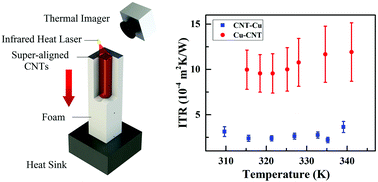Interfacial thermal resistance and thermal rectification in carbon nanotube film-copper systems†
Abstract
Thermal rectification occurring at interfaces is an important research area, which contains deep fundamental physics and has extensive application prospects. In general, the measurement of interfacial thermal rectification is based on measuring interfacial thermal resistance (ITR). However, ITRs measured via conventional methods cannot avoid extra thermal resistance asymmetry due to the contact between the sample and the thermometer. In this study, we employed a non-contact infrared thermal imager to monitor the temperature of super-aligned carbon nanotube (CNT) films and obtain the ITRs between the CNT films and copper. The ITRs along the CNT–copper direction and the reverse direction are in the ranges of 2.2–3.6 cm2 K W−1 and 9.6–11.9 cm2 K W−1, respectively. The obvious difference in the ITRs of the two directions shows a significant thermal rectification effect, and the rectifying coefficient ranges between 0.57 and 0.68. The remarkable rectification factor is extremely promising for the manufacture of thermal transistors with a copper/CNT/copper structure and further thermal logic devices. Moreover, our method could be extended to other 2-dimensional materials, such as graphene and MoS2, for further explorations.



 Please wait while we load your content...
Please wait while we load your content...